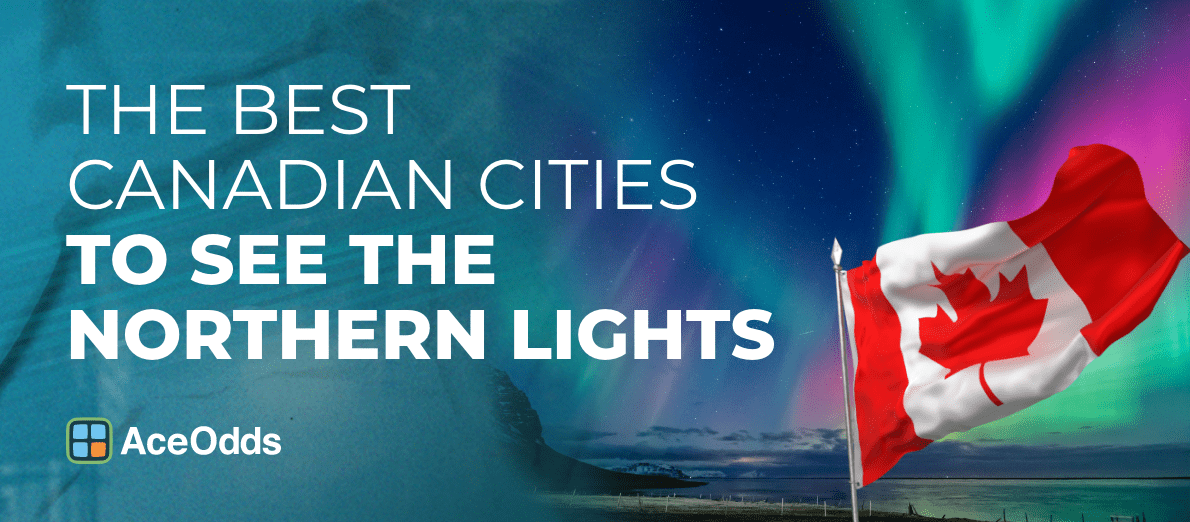
Here at AceOdds we have studied levels of light pollution, average hours of clear skies and distance to the North Pole of each location to rank and reveal the Canadian cities with the best chance of seeing the Northern Lights.
A recent study by AceOdds, has revealed the best cities to visit in Canada to increase your chances of seeing the Northern Lights this year.
Currently, the levels of solar activity are at the highest they have been in 20 years, and this is set to peak somewhere between the 2024 - 2025 season - meaning that now is the perfect time to discover the Aurora Borealis (Northern Lights).
Best Canadian Cities to see the Aurora
By analysing the main factors attributing to being able to see these natural wonders, Yellowknife was revealed as the most likely place to witness the Northern Lights. This may not come as a surprise, with it being the closest city in the study to the North Pole (1904 miles away). However, it also ranked highly for clear skies (16th out of 82) and for visibility (11th out of 82).
City |
Province |
Distance to North Pole (Miles) |
Clear skies (Hours) |
Most hours with low visibility |
SQM mag./arc sec2 (light pollution) |
Index Score |
|---|---|---|---|---|---|---|
Yellowknife |
NT |
1904 |
2347.6 |
64.85 |
19.32 |
81 |
Cold Lake |
AB |
2455 |
2208.31 |
82.15 |
20.66 |
76 |
Fort McMurray |
AB |
2298 |
2265.75 |
54.95 |
19.26 |
74 |
Whitehorse |
YT |
2023 |
1631 |
62.47 |
19.51 |
74 |
Thompson |
MB |
2362 |
2447.36 |
79.02 |
19.2 |
71 |
Kenora |
ON |
2487 |
2419 |
140.02 |
19.58 |
71 |
Yorkton |
SK |
2676 |
2666.93 |
95.83 |
19.74 |
71 |
Estevan |
SK |
2823 |
2880.53 |
109.16 |
20.02 |
69 |
Prince Albert |
SK |
2542 |
2539.82 |
99.79 |
19.17 |
69 |
Securing the second spot is Cold Lake, thanks to ranking third lowest for light pollution in the study. Fort McMurray follows in third place, having the sixth-highest visibility score and is the third-closest city to the North Pole. Followed by Whitehorse, which is the second closest city to the North Pole.
St John’s, NL, is revealed to be the Canadian city with the lowest chance of being able to see the Northern Lights, primarily due to having the third-lowest hours of clear skies (1187.48 hours) and the highest hours of low visibility (763.98 hours) in the whole study.
Best Cities by Province
The study also analysed data to uncover the cities within each province that provide the best chances of viewing the Northern Lights.
Yellowknife in Northwestern Territories has the highest overall score of 81/100, followed by Cold Lake, Alberta (76), and Whitehorse, Yukon (74).
City |
Province |
Distance to North Pole (miles) |
Clearest skies (hours) |
Hours with low visibility (hours) |
SQM mag./arc sec2 |
Total Index Score / 100 |
|---|---|---|---|---|---|---|
Yellowknife |
Northwest Territories |
1904 |
2347.6 |
64.85 |
19.32 |
81 |
Cold Lake |
Alberta |
2455 |
2208.31 |
82.15 |
20.66 |
76 |
Whitehorse |
Yukon |
2023 |
1631 |
62.47 |
19.51 |
74 |
Thompson |
Manitoba |
2362 |
2447.36 |
79.02 |
19.2 |
71 |
Kenora |
Ontario |
2487 |
2419 |
140.02 |
19.58 |
71 |
Yorkton |
Saskatchewan |
2676 |
2666.93 |
95.83 |
19.74 |
71 |
Baie-Comeau |
Québec |
2817 |
2298.32 |
185.77 |
21.22 |
67 |
Fort St. John |
British Columbia |
2331 |
2139.54 |
130.33 |
18.91 |
64 |
Cranbrook |
British Columbia |
2790 |
2258.17 |
60.44 |
20.21 |
64 |
Bathurst |
New Brunswick |
2927 |
2333.75 |
165.27 |
20.27 |
60 |
Summerside |
Prince Edward Island |
3012 |
2122.22 |
188.85 |
20.08 |
57 |
Gander |
Newfoundland and Labrador |
2836 |
1302.64 |
387.72 |
21.88 |
55 |
Kentville |
Nova Scotia |
3103 |
1685.9 |
140.6 |
20.64 |
48 |
While those may be the best three in this list, the study also found that Yorkton in Saskatchewan, Thompson in Manitoba and Kenora in Ontario were the top three cities to have the highest hours of clear skies in this list, which is a major factor in witnessing the Northern Lights.
Cranbrook, British Columbia, ranked the best for visibility in the top cities in each province. Meanwhile, Gander in Newfoundland and Labrador, Baie-Comeau in Québec, and Cold Lake in Alberta were the top three cities with the lowest light pollution.
How to increase your odds of seeing the Northern Lights
You are most likely to spot the Northern Lights during the Winter months (December - March) due to this time of the year having darker nights and typically clearer skies. To further increase your odds, the best time for catching a glimpse of the natural wonder is between 10 pm and 2am.
Methodology
Comment taken from Dr Shannon Schmoll, Director of the Abrams Planetarium at Michigan State University.
Study data was calculated by taking every Canadian City (50,000+ population) and looking at each area's Light Pollution Data (SQM mag./arc sec2), average hours of clear skies per year, average hours with low visibility each year and distance to the North Pole. This data was then analysed and each city was ranked based on data found.
About AceOdds
AceOdds provides the most comprehensive and reliable suite of bet calculators. Our expertise also extends to finding the best bonus codes and sign up promotions with the occasional tip-off from our shrewd user base.
Learn More. Advertising Disclosure.